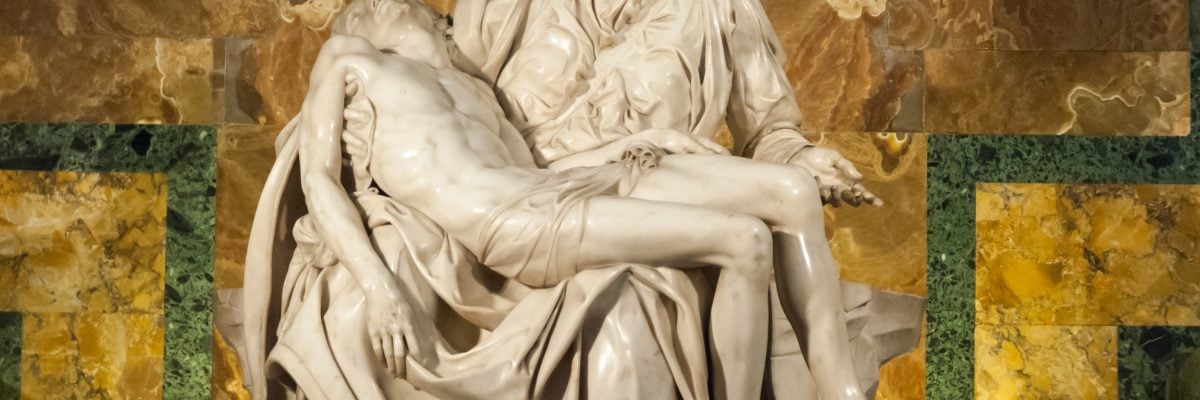
In March, Pope Francis added a new memorial to the liturgical calendar: Mary, Mother of the Church. Today—and each day after Pentecost henceforth—we celebrate this wonderful new feast. This recognition of Mary’s ecclesial motherhood goes back to Patristic times, and indeed, can be found right in the Gospels, when Jesus gives Mary to John, the beloved disciple and representative of all Christians, to be his (and thus the Church’s) mother (John 19:27). John confirms in Revelation 12:17 that “those who keep the commandments of God and bear testimony to Jesus” are Mary’s children.
Vatican II’s Dogmatic Constitution on the Church, Lumen Gentium, adds:
This maternity of Mary in the order of grace began with the consent which she gave in faith at the Annunciation and which she sustained without wavering beneath the cross, and lasts until the eternal fulfillment of all the elect. Taken up to heaven she did not lay aside this salvific duty, but by her constant intercession continued to bring us the gifts of eternal salvation (62)
Mother of the Church is just one of the titles and truths about Mary that the Church celebrates. Many of these, though, are points of contention for our Protestant brothers and sisters. On this joyful occasion, then, let us look at a few and offer a few words of support for each from the Fathers of the Church.
- Mother of God
For our God, Jesus Christ, was, according to the appointment of God, conceived in the womb by Mary, of the seed of David, but by the Holy Ghost. He was born and baptized, that by his passion he might purify the water (St. Ignatius of Antioch, Letter to the Ephesians, 18,2, ca. A.D. 107).
“God… was born.” You do the math.
The Virgin Mary… being obedient to his word, received from an angel the glad tidings that she was to bear God (St. Irenaeus, Against Heresies, 5:19:1, ca. A.D. 177).
Under your mercy, we take refuge, Mother of God, do not reject our supplications in necessity. But deliver us from danger, [O you] alone pure and alone blessed (Sub Tuum, A.D. 250. This ancient Coptic Catholic prayer was sung as a hymn).
- The Immaculate Conception
If we consider just Mary’s ancient title of New Eve taught by the Fathers from both East and West, the Fathers are unanimous.
Not all explicitly conclude Mary to be sinless from the image of the “New Eve,” but it follows nonetheless. If you understand that all Old Testament “types” are inferior to their New Testament fulfillments, to say Mary would have been conceived in sin and to have fallen into sin would make her inferior to Eve, who did not receive nearly the grace that Mary received.
Here are two of the earliest examples:
Whereof if thou bear the tree and pluck the fruit, thou shalt ever gather the harvest which God looks for, which [the] serpent toucheth not, nor deceit infecteth, neither is Eve corrupted, but is believed on as a virgin, and salvation is set forth (The Epistle of Matheiteis to Diognetus, A.D. 140).
This ancient text does not explicitly name the New Eve as Mary, but she is implied in the reference to her being “believed on as a virgin.” She is depicted as being the opposite of Eve who had been corrupted.
Mary and Eve, two people without guilt, two simple people, were identical. Later, however, one became the cause of our death, the other the cause of our life (St. Ephrem of Syria, Op. Syr. II 37, ca. 360).
- Perpetual Virgin
On this point, the Fathers of the Church were also unanimous. Here are three early examples:
The Protoevangelium of James (ca. A.D. 140): According to the renowned Patristics scholar Johannes Quasten, “The principal aim of the whole writing is to prove the perpetual and inviolate virginity of Mary before, in, and after the birth of Christ.”
Clement presents Mary as a sort of archetype of the scriptures, which also give birth (to the truth) yet remain virginal. He similarly viewed Mary as the archetype of the Church, the ever-virginal bride of Christ. Both were virgins who give birth yet remain virgins: “She (the Church) is virgin and Mother simultaneously; a virgin undefiled and a mother full of love” (St. Clement of Alexandria, The Instructor, bk. I, ch. 6, ca. A.D. 200).
Mary, as those declare who with sound mind extol her, had no other son but Jesus. Origen, Commentary on John, bk. I, ch. 6, ca. 230).
- Assumed into Heaven
Recently discovered Syriac fragments of written stories about the Assumption of Mary have now been dated as early as the third century. Far from rejecting the Assumption, we find the opposite among the Fathers.
[Mary] is immortal to the present time through him who had his abode in her and who assumed and raised her above the higher regions” (Timothy of Jerusalem, Homily on the Prophet Simeon and the Blessed Virgin Mary, ca. 350-390).
Like the bodies of the saints, however, she has been held in honor for her character and understanding. And if I should say anything more in her praise, she is like Elijah, who was virgin from his mother’s womb, always remained so, and was taken up, but has not seen death (St. Epiphanius, Panarion 79: 5,1, A.D. 360).
And behold, again the Lord stood by them; and the holy body having been received, He commanded that it be taken in a cloud into paradise; where now, rejoined to the soul, [Mary] rejoices with the Lord’s chosen ones and is in the enjoyment of the good of an eternity that will never end (St. Gregory of Tours, Eight Books of Miracles 1:4, A.D. 590).
- Co-Redemptrix and Mediatrix
As stated above, the Fathers of the Church are unanimous when it comes to Mary as “the New Eve.” The majority of the references to Mary with this title refer explicitly to her unique role in God’s plan of salvation. St. Irenaeus is an excellent example of what we find peppered throughout the age of the Fathers:
Eve… having become disobedient, was made the cause of death, both to herself and to the entire human race; so also did Mary… by yielding obedience, became the cause of salvation, both to herself and the whole human race (Against Heresies, bk. 3, ch. 22).



